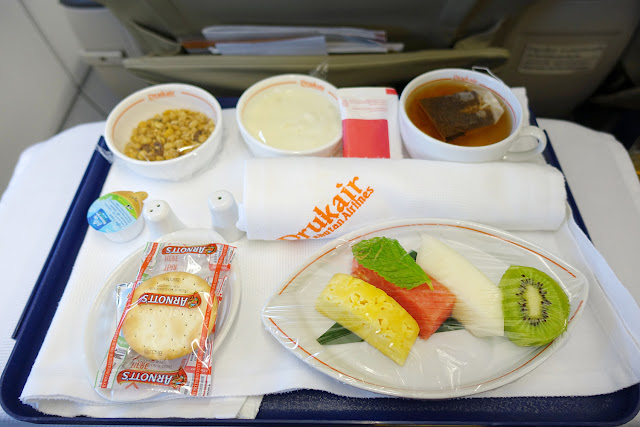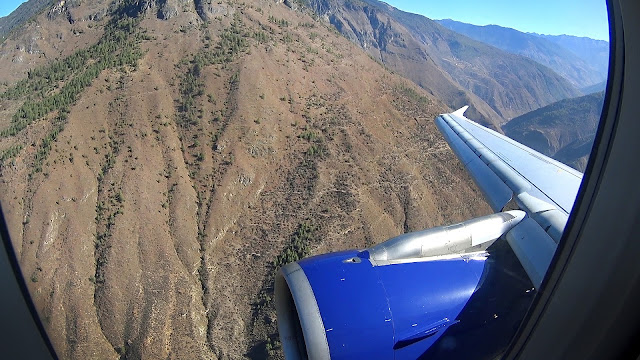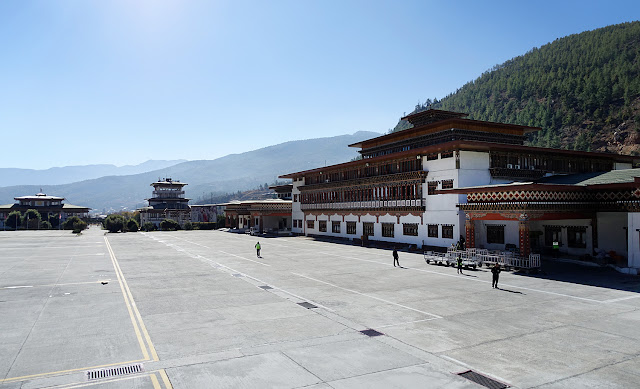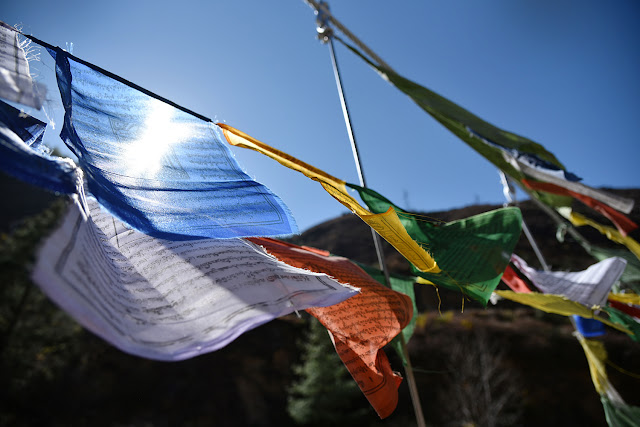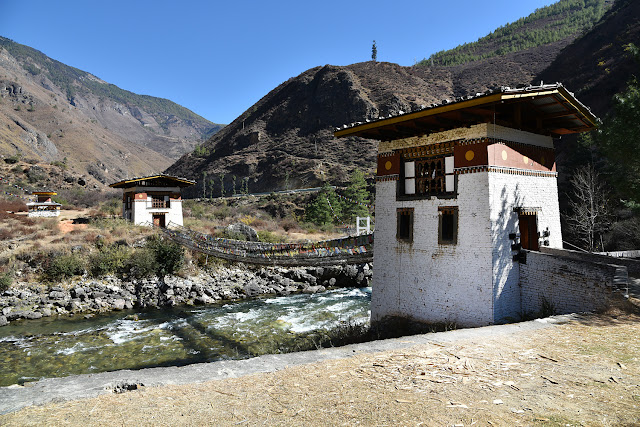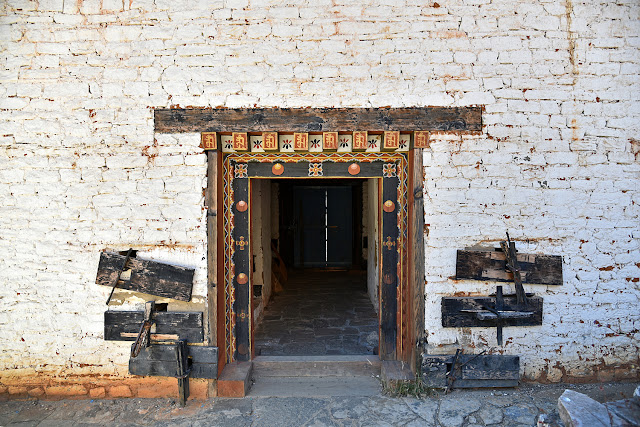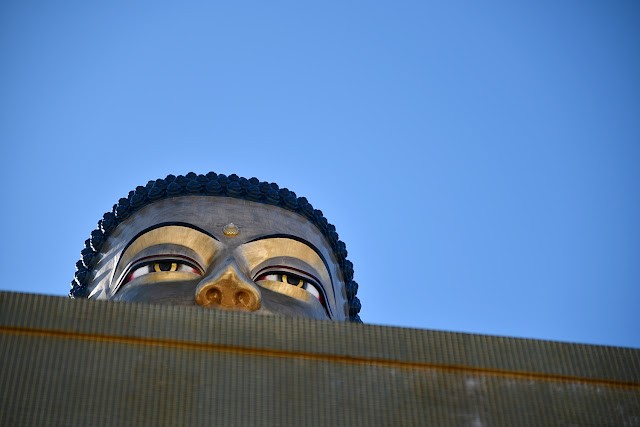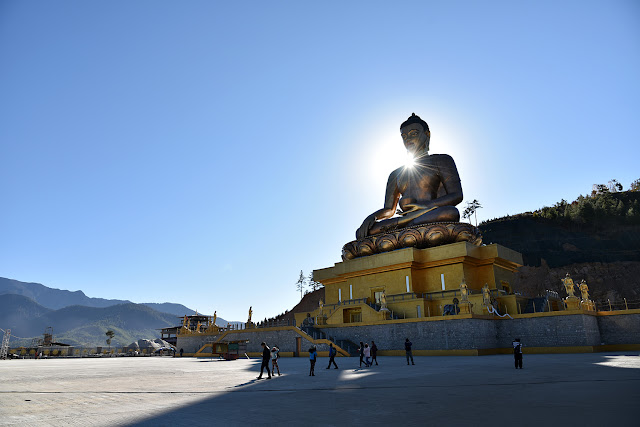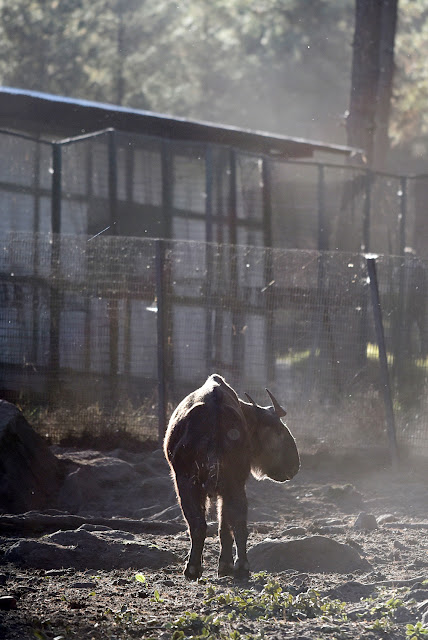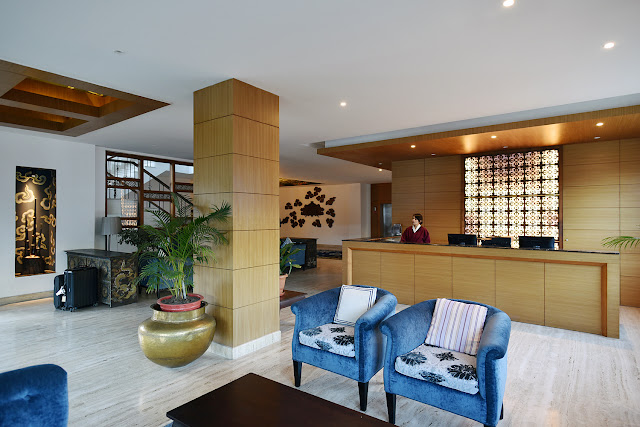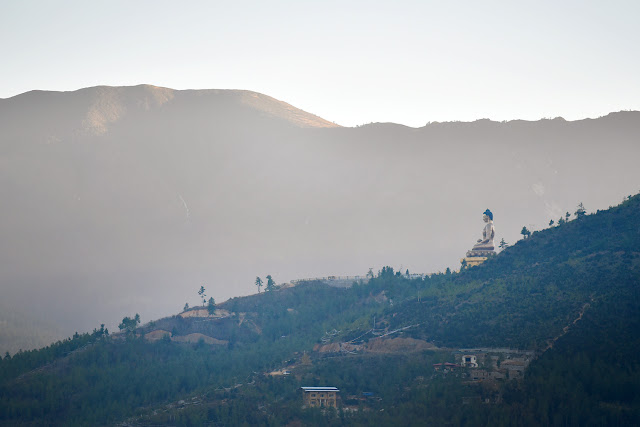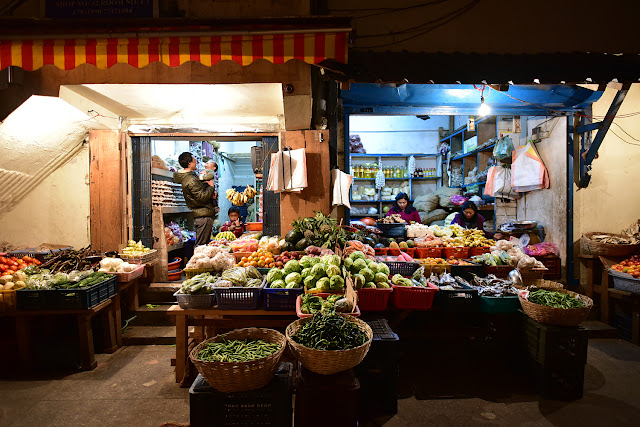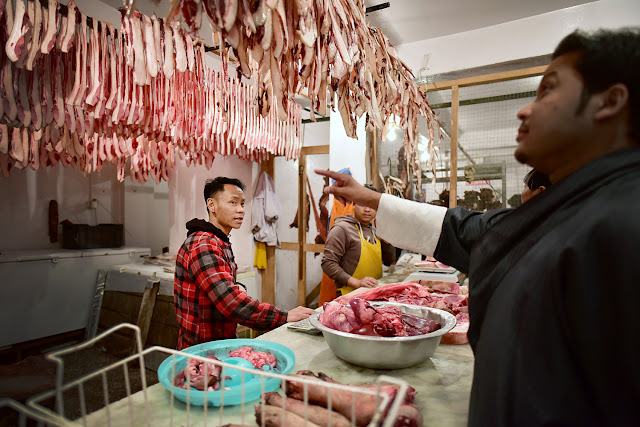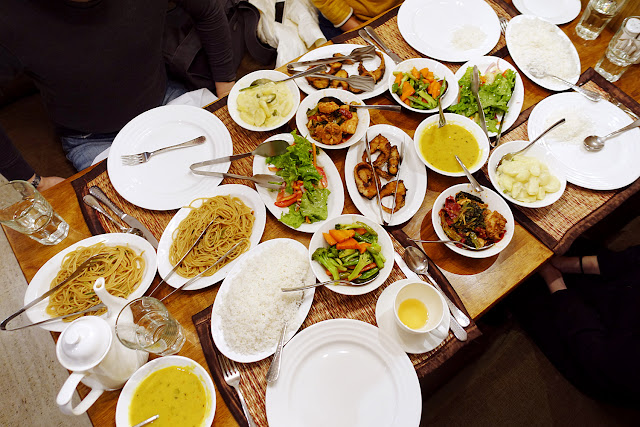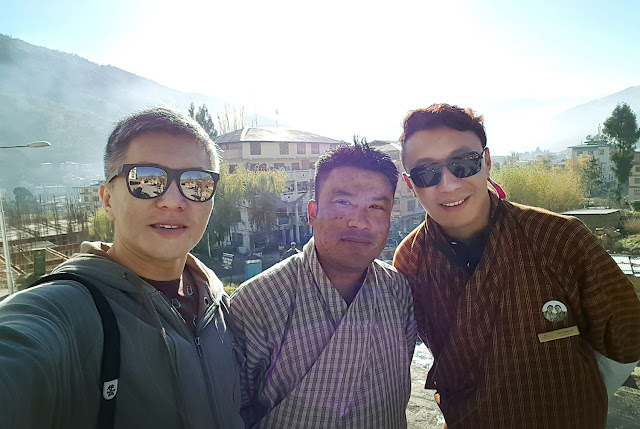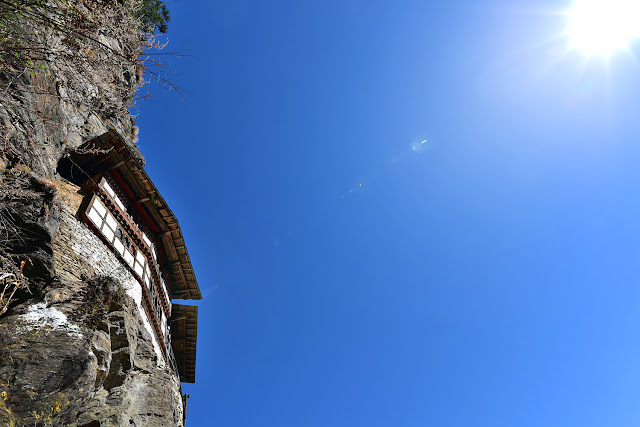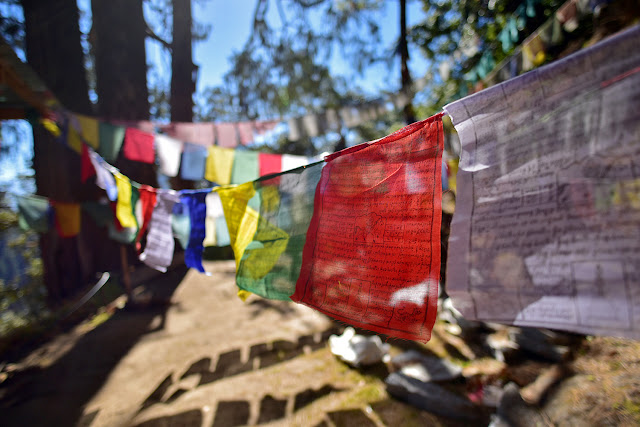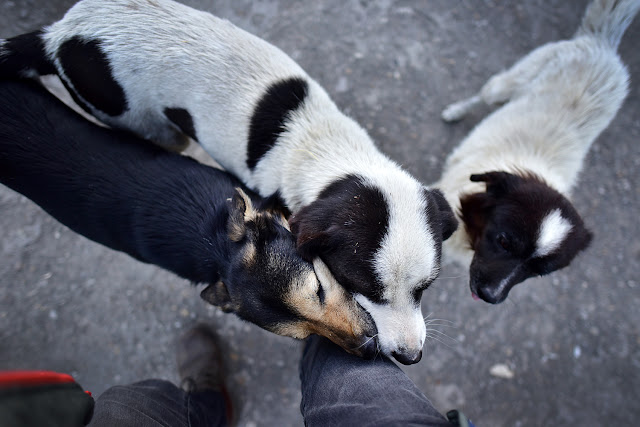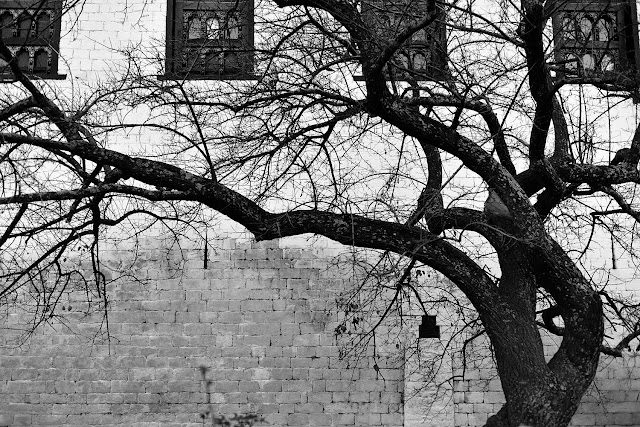The familiar voice of our flight attendant filled the humming cabin air through the PA system once again. I sat up and looked out of my aircraft window with much excitement, guessing that it must be an announcement to prepare for landing while she was still speaking melodiously in Dzongkha.
The distant snow-capped Himalayan mountains we saw less than an hour ago had became velvety mountains in green and ochre within an arm's reach from the aircraft window. Our plane was no longer flying over mountains but between.
The descend to Paro International Airport was swift, ephemeral and nerve-racking to say the least. The sense of anxiety grew as I continued to stare out of my window, watching the plane rolled and pitched its way between the narrow valley in search of its landing approach, with its silver wing tip gliding past the face of the mountain like a finger running gently along its topography lines.
As the pilot skilfully manoeuvred the Airbus A319 through the narrow Paro valley, twisting and turning the 50 ton aircraft like a toy in a boy's hand, I was reminded that we were not approaching another award-decorated metropolis airport but one that has been named as the world's most dangerous to land.
As the plane glided just metres above the Bhutanese houses at 150 mph, barely scraping their zinc roofs and finally making a safe landing on the air strip laid 2,280m above sea level, I was reminded that this wasn't just another mainstream holiday city but one of the most exotic and alluring destinations in many travellers' wish lists, including of mine.
Indeed, this place is so special and sacred that only 8 pilots in the world are qualified to land on its short 2 km asphalt. It is so well hidden like a best-kept ancient secret, sandwiched and guarded by some divine power amidst a labyrinth of sacred valleys.
"Tashi Delek." The flight attendant greeted while the plane taxied towards the humble airport terminal.
Welcome to Bhutan - Land of the Thunder Dragon.
Bhutan has always been a place we have wanted to visit as long as we could remember. Other than its genuinely gorgeous sceneries and immaculately preserved culture, the wedding of Hong Kong celebrities Tony Leung and Carina Lau had certainly added a touch of modern publicity to this exotic destination.
Not forgetting their charismatic King and charming Queen of Bhutan who have touched and melted many hearts and brought the sleepy country out from the deep Himalayan shadows into the glamorous Hollywood spotlight.
Without hesitation, we decided on our common available dates with 2 other friends from Taiwan and booked our flights straightaway. Honestly, we were all hoping and more eager to meet His Majesty King Jigme Khesar Namgyel Wangchuck and Her Majesty Jetsun Pema than seeing the famed Tiger's Nest.
We booked everything through Druk Asia, a perfect one-stop centre for Bhutan travel arrangements (https://www.drukasia.com/). Using their many tour packages as templates, we were able to customise our itinerary easily through their helpful advisors. From air tickets and visas to reservations and payments, everything was done via email and internet banking. Alternatively, the friendly staff stationed at their office in Albert Complex (Singapore office) are always ready to meet and assist.
There is no direct flight from Singapore to Paro International Airport. All flights transit at Kolkata, in which passengers need not disembark during the 40-min layover. There are only 3 flights per week from Singapore to Bhutan - on Tuesday, Thursday and Sunday.
As Druk Air (Royal Bhutan Airlines) does not offer online check-in, you may wish to reach Changi Airport earlier for check-in if you want to secure a window seat. Many sources would suggest taking a window seat on the left as you will be able to see the majestic Himalayan range while traversing from Kolkata to Paro. However, on descend into Paro, I personally prefer the views on the right side as the plane sweeps around the mountain.
Ticket to happiness on KB501. Only 3 flights per week, all departing at 6.30am (8.30am in some months). The early departure is necessary as wind condition makes landing at Paro Airport after 12 noon more difficult.
Happy meal. Simple but comforting breakfast on board.
The distant Himalayan mountain range as seen from the window on the left of the aircraft when flying between Kolkata and Paro.
Hopped over to an empty seat on the right for a new perspective.
Every movable part of the wing could be seen working extra hard to manoeuvre the plane. Descending and getting closer to the mountains - twisting, turning and gliding through the valleys for landing. Seriously, the mountains felt much closer in reality than the photo suggests.
A short video of the landing could be seen here:
https://www.youtube.com/watch?v=0_nQ8KazQnE&t=32s
The Paro International Airport terminal building. Disembarkation and immigration were swift and hassle-free. Our guide and driver were already waiting for us at the arrival hall, holding my name high and clear.
There is no aero-bridge or carpeted arrival lounge. But walking out of a passenger jet sitting in the middle of a valley felt rather intriguing. Despite being only half the length of Changi Airport's runway, landing was swift and smooth. A big salute to the skilful pilot! And you may take your time to take pictures with the plane, the airport security didn't seem to mind.
Our driver, Mr. Sangye (middle) helping with our luggage. All travellers in Bhutan will get their personal guide, driver and vehicle, except for those on big tour groups. Hence, the USD250 per person per night (peak season) or USD200 per person per night (off-peak season) is very reasonable. Not forgetting that it includes accommodation and all 3 meals daily!
Our first stop was the Tachog Lhakhang and the iron chain bridge across the river Paro Chhu. It's located conveniently along the way from Paro to Thimphu, which was where we were heading.
Prayer flags adorn the bridge, fluttering prayers and blessings for more than 600 years.
The bridgeheads on both sides of the river.
The iron chain bridge from one end to the other.
Anchoring the iron chains for centuries.
Our first stop in Thimphu was the National Memorial Chorten. It was built in 1974 as a memorial to Jigme Dorji Wangchuk, the third king of Bhutan (1928-1972).
There was a big prayer event at the National Memorial Chorten, with hundreds of locals gathering at the compound.
The majestic and iconic stupa of the National Memorial Chorten, also known as the Thimphu Chorten.
The locals were always friendly and happy to pose for a photo. Starting to feel the real happiness of the Bhutan people.
A local standing in front of giant prayer wheels.
Guess who was watching over us...
Arrived at the Buddha View Point. At 169 feet tall and perched high on the mountain of Thimphu valley, the shimmering bronze and gold-glided statue of Buddha Dordenma can be seen from anywhere in Thimphu. It's known to be one of the largest seated Buddha statues in the world.
A short 20-minute drive from Buddha View Point is the Motithang Takin Preserve, home to Bhutan’s national animal, the Takin.
Locals and caretakers at the Takin Preserve.
It wasn't easy getting a good look (or a picture) of this shy and beautiful animal.
Day one's programme was light and easy. Thanks for our considerate guide, Mr. Jigme Dorji, whom we could always discuss our lazy plans with. We were not ambitious about our itinerary and wanted to take things slowly. Hence, we headed to our hotel and checked-in by 6pm.
A great view of Thimphu valley from our hotel room. See if you could spot the golden statue of Buddha Dordenma perched on the mountain.
Buddha spotting with the help of 300mm (200mm with 1.5X sensor crop setting on my D750).
We stayed with Hotel Osel in Thimphu. We did not specify our hotel preferences and they were selected and booked by Druk Asia based on availability, as we were not fussy and there wasn't a lot to choose from in each city anyway. To our pleasant surprise, Hotel Osel was clean, spacious and well-equipped. And best of all, the main shopping streets of Thimphu is located less than 10-minute walk from the hotel.
Decided to take on the streets of Thimphu and soak in the local street atmosphere.
Presumably, this is the "Orchard Road" of Bhutan - the capital's main shopping street.
Fresh produce along the alleys of Thimphu. Bhutan still relies significantly on food imports from neighbours like India.
Locals transacting in a rather unusual meat shop.
It's dinner time and back to the comfort of Osel Hotel. The hotel restaurant was clean and spacious. Service was also impeccable! Thanks to Mr. Pema Dorji at Osel!
Our sumptuous dinner spread. The warm and hospitable hotel staff had never failed to attend to our needs and were always checking on us. Mr. Pema was always asking if the food had suited our taste and the kitchen could always adjust accordingly. We were really amazed by their superb service.
From the contagious laughter of our tour guide and driver to the blushful charming smiles of every Bhutanese we had met along the way, perhaps, happiness is really a place on Earth.
Continue Day 2...
GENERAL TIPS AND USEFUL INFO:
Date of trip: 6 to 14 December 2016
Accommodation:
- Osel Hotel, Thimphu
- Hotel Lobesa, Punakha
- Tashi Namgay Resort, Paro
- COMO Uma Paro, Paro (additional stay)
Weather in Dec is cool and beautiful. The sun can be harsh and intense in the day. A pair of shades and sunblock would be good to have.
It could get warm in the day, especially when trekking up the mountains for hours. The option to layer multiple light clothing would be more sensible and convenient than one thick and heavy jacket. Temperature typically ranged from 15 to 20 degrees Celsius in the day, to freezing temperatures at night. Some hotels may not have very effective room heater. Hence, bring warm pyjamas just in case. Consider bringing a hot water bag to snug under your blanket (Hotel Lobesa had provided 2 and they were God-sent on that freezing night).
When visiting temples, Dzongs and places of importance, long pants and collared shirts/jackets would be required. For ladies, please wear long pants/skirts throughout the trip. Several places would require shoes to be removed before entering. Consider the ease of footwear removal if you do not wish to spend excessive time meddling with shoelaces.
A set of traditional attire - the Gho and Kira will be prepared for all tourists. You may choose to wear it any day, or every day. The tour guide and driver will guide you through the art of wearing.
Road condition was bad, as most roads were under repair or construction. The terribly bumpy road surfaces coupled with windy mountainous roads was the perfect formula for some dramatic motion sickness. Prepare for the worse - motion sickness medication, sour plum, mints, Axe Brand medicated oil, Tiger Balm; arm with them all if you need. If you know you are going to fall victim easily, request to swap with the tour guide for a front passenger seat, which I did for some parts of the journey before becoming Singapore's vomiting icon.
Food was delectable and palatable. The 4 of us, 2 Singaporeans and 2 Taiwanese, had all enjoyed every meal with smiles and praises. Ask for their local condiments and chilli to add some exciting flavours to your meal. Staff at any restaurant would usually be happy to serve. Their local chilli cheese (Ema Datshi) would also fire up any bland meal you may find. Ask what your tour guide and driver are eating and you may be in for some flavourful surprises.
Tuesdays are "Dry Days", which means, no alcoholic drinks are available.
GETTING STARTED
Visit Druk Asia (https://www.drukasia.com/) and start planning using their wide range of packages as a starting point. Contact their friendly staff if you have any question or would like to customise any part of the itinerary. It's not necessary to follow the itinerary strictly. You could arrange with your personal guide and work out a more "free-and-easy" programme when you are there. But your guide and driver would always be with you as there is no other way to get around this country.
It's best if you book through Druk Asia and going as a small group with just your family or friends instead of booking tours through big travel agencies. You'll then be getting your own tour guide, driver and vehicle.
The USD200 (off-peak) or USD250 (peak) per person per night includes accommodation, meals, and everything one needs in a day, minus frills and shopping. Ample bottled drinking water is provided daily in your personal vehicle and there is really no need to spend a single cent except for souvenirs, or at the Centenary Farmer's Market (Thimphu), if you are a fan of local flavours and ingredients.
For info on entry visa, daily tariff, and FAQs can be found here:
SOME PHOTOGRAPHY NOTES:
The sun can be harsh and intense in the day during this season. As you can see from the photos, most days were cloudless, which means intense direct sunlight hitting on your subject. The extreme high contrast in highlights and shadows would be a constant challenge for your camera's dynamic range. A fill-flash could be needed to eliminate harsh shadows on faces.
Carry light as there will be a lot of walking. Below are some popular places and their timings (based on our poor physical condition and carefree pace):
- Tango Cheri Monastery, Thimphu - 75 to 90 mins ascend, 60 to 70 mins descend.
- Chimi Lhakhang, Punakha - 40 to 45 mins (one-way) across the valley, paddy, and uphill.
- Pho Chhu Suspension Bridge, Punakha - 20 mins (one-way) from Punakha Dzong.
- Haa Valley View Trail - 60 mins descend (optional trekking to lunch).
- Tiger's Nest Ascend First Section - 40 mins by horse, or 90 mins by foot.
- Tiger's Nest Ascend Second Section - 120 mins by foot only.
- Tiger's Nest Descend - 80 mins + 50 mins (usually with lunch in-between).
Bhutanese are generally very friendly and approachable. Most would love to have their photos taken. They are indeed a happy bunch and do not be shy to ask for a picture (wish I had done that more). Regardless, respect their preference and personal space.
Some parts of temples and Dzongs do not allow photography, with or without flash. Please check with your tour guide if unsure before firing off like there's no tomorrow. Show necessary respect to the people, culture and religion, please.
And here's what I've brought and used for this trip (was a tough decision):
- Nikon D750
- Nikon AF 16mm f2.8D Fisheye
- Nikon AFS 20mm f1.8G ED
- Nikon AFS 50mm f1.4G
- Nikon AFS 24-120mm f4G ED VR
- Nikon AFS 70-200mm f4G ED VR
- Sony RX100 III
- Sony X1000V Action Cam
- Samsung Gear 360 (paired with Samsung S7)
- ONA Messenger Bag - The Union Street
SO, TO VISIT OR NOT? WHEN TO VISIT?
Still trying to read up endless travel blogs and wondering whether you should be visiting Bhutan, or when you should be? First, it's a myth that Bhutan is expensive, because the daily charges cover everything! Second, it's not true that it's hard to get a tourist Visa (in the case of Singaporeans). It could be more difficult to get an air ticket during peak season simply due to the limited flights into the country.
It doesn't matter if it's the Happiness you are after or the Thunder Dragon you are seeking; or for us, just the Dragon King we were hoping to meet, there is every reason to make a trip to this magnificent country at least once in our lives. Or is there even the need for a reason at all?
"It doesn't matter when you get married
as long as it is the right person."
His Majesty Jigme Khesar Namgyel Wangchuck on his Royal Wedding, 13 Oct 2011
As the King has rightly said, visiting Bhutan is perhaps as emotional and impassioned as his big day. It doesn't matter when, which season, as there is no right time or best time to visit this lovely country, because it is certainly the right and best place to be.

